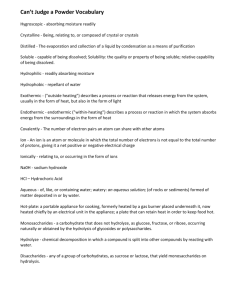Lecture 4 Biomaterials Surfaces: Chemistry
advertisement
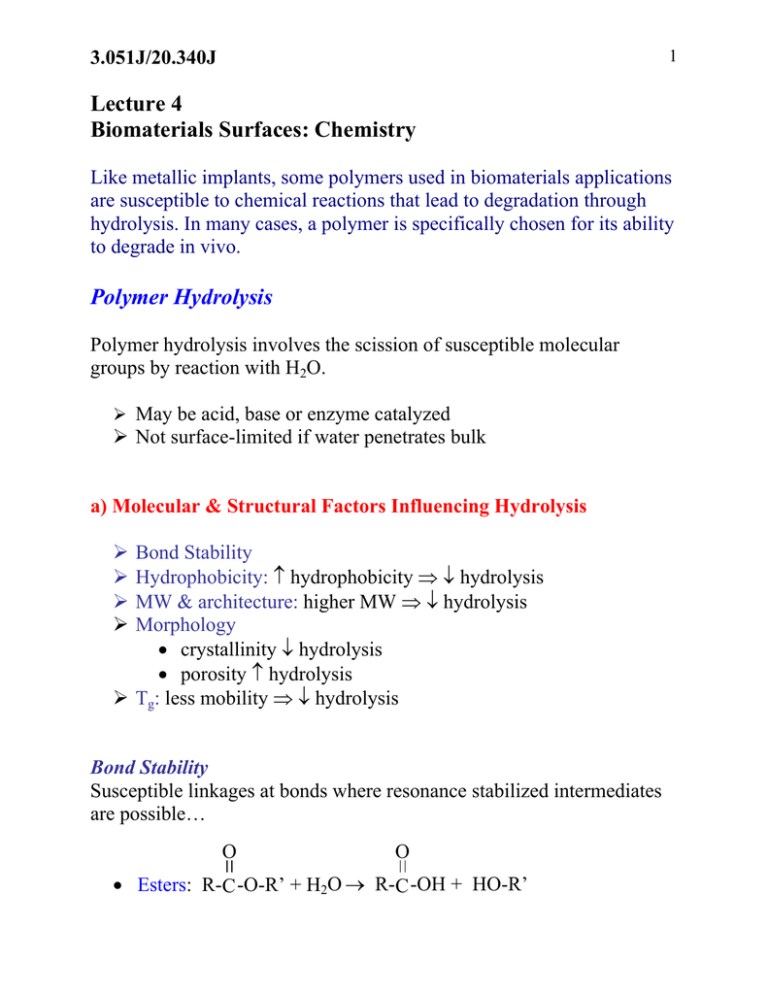
1 3.051J/20.340J Lecture 4 Biomaterials Surfaces: Chemistry Like metallic implants, some polymers used in biomaterials applications are susceptible to chemical reactions that lead to degradation through hydrolysis. In many cases, a polymer is specifically chosen for its ability to degrade in vivo. Polymer Hydrolysis Polymer hydrolysis involves the scission of susceptible molecular groups by reaction with H2O. ¾ May be acid, base or enzyme catalyzed ¾ Not surface-limited if water penetrates bulk a) Molecular & Structural Factors Influencing Hydrolysis ¾ ¾ ¾ ¾ Bond Stability Hydrophobicity: ↑ hydrophobicity ⇒ ↓ hydrolysis MW & architecture: higher MW ⇒ ↓ hydrolysis Morphology • crystallinity ↓ hydrolysis • porosity ↑ hydrolysis ¾ Tg: less mobility ⇒ ↓ hydrolysis Bond Stability Susceptible linkages at bonds where resonance stabilized intermediates are possible… O O • Esters: R-C -O-R’ + H2O → R-C -OH + HO-R’ 2 3.051J/20.340J Example 1: poly(lactide-co-glycolide) Properties: rapid degradation, amorphous, Tg ~ 45-55°C Uses: bioresorbable sutures, controlled release matrices, tissue engineering scaffolds O O (-O-CH(CH3)-C -)x-r-(-O-CH2-C -)y lactic acid glycolic acid Example 2: polyethylene terephthalate (Dacron) Properties: very slow hydrolysis, semicrystalline, Tg~ 69°C Uses: vascular grafts, arterial patches, heart pumps O O C O- CH2 - CH2 -]N [-O C base-catalyzed polyester hydrolysis: OH— O C R •• • • • O• OR’ C R O C OH R O R’ H H •O • • • + HOR’ + OH— OH 3 3.051J/20.340J acid-catalyzed polyester hydrolysis: H+ X • • •O • C OR’ R + • •O C R H H X H H •O • • • OR’ H •O • • • O−H C R O R’ X •• O+ H O H C R O + HOR’ H3O+ X OH O • Amides: R-C -NH-R’ + H2O → R-C -OH + H2N-R’ amide or peptide linkage, also found in proteins! O O Example: Nylon 6,6 (-NH-(CH2)6-NH-C -(CH2)4-C -)N poly(hexamethylene adipamide) Properties: ~9% H2O uptake, semicrystalline, Tg~50°C Uses: removable sutures, prosthetic joints 4 3.051J/20.340J O O O O • Anhydrides: R-C -O-C -R’ + H2O → R-C -OH + HO-C -R’ O O (-(CH2)8- C -O-C -)N Example: poly(sebacic acid anyhydride) Properties: rapid degradation (surface-based) Uses: drug delivery matrices • Ethers: R-O-R’ + H2O → R-CH2-OH + HO-CH2-R’ Example: polyethylene oxide (PEO) (-CH2-O-CH2-)N Properties: water soluble, semicrystalline, Tg ~ -60°C Uses: hydrogels, protein-resistant coatings O O • Urethanes: R-NH-C -O-R’ + H2O → R-NH-C -OH + HO-R’ Example: polyether urethane O [(-(CH2)4-O-)xC -NH O CH2 NHC -O-]N – [hard block] – Properties: “soft” block of SPU “Biomer”, slow hydrolysis Uses: pacemaker lead sheaths & connectors 5 3.051J/20.340J O O • Ureas: R-NH-C -NH-R’ + H2O → R-NH-C -OH + H2N-R’ O O • Carbonates: R-O-C -O-R’ + H2O → R-O-C -OH + HO-R’ Rates of Hydrolysis: anhydride > ester > amide > ether Stable Polymer Chemistries: • Olefins e.g., UHMWPE: joint cup liners • Halogenated hydrocarbons e.g., PVC: catheters; PTFE: vascular grafts • Siloxanes e.g., PDMS: soft tissue prostheses • Sulfones e.g., PSf: renal dialysis membranes 3.051J/20.340J b) Biological Factors Influencing Hydrolysis • pH variations inflammation/infection ⇒ ↓pH, catalyzes hydrolysis • Hydrolases—enzymes that catalyze hydrolytic reactions ¾ Proteolases: catalyze hydrolysis of peptide bonds ¾ Esterases: catalyze hydrolysis of ester bonds ¾ Produced by phagocytic cells c) Influence of Hydrolysis on In Vivo Performance ¾ Loss of structural integrity e.g., i) polyester urethanes: rapid degradation in orthopedic reconstructions (no longer used) ii) PET fibers: deterioration after long periods in cardiovascular applications ¾ Toxicity/mutagenicity e.g., i) segmented polyurethanes (SPUs): suspected tumorigenicity of degradation products ii) cyanoacrylates (soft tissue adhesive): hydrolysis generates formaldehyde 6

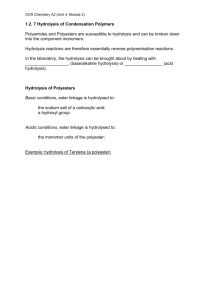
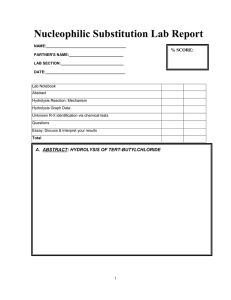
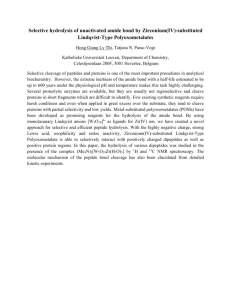
![Name: .[printed]](http://s2.studylib.net/store/data/013223452_1-16d694c84e5633632176744e9d5c5914-300x300.png)
